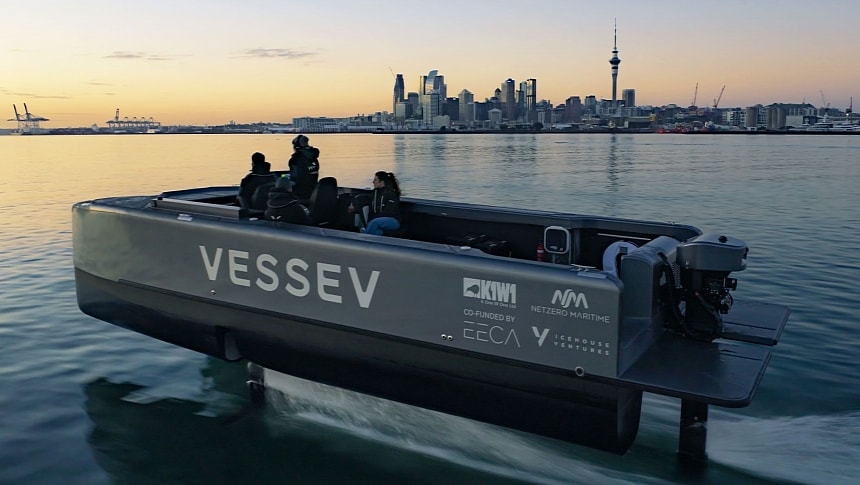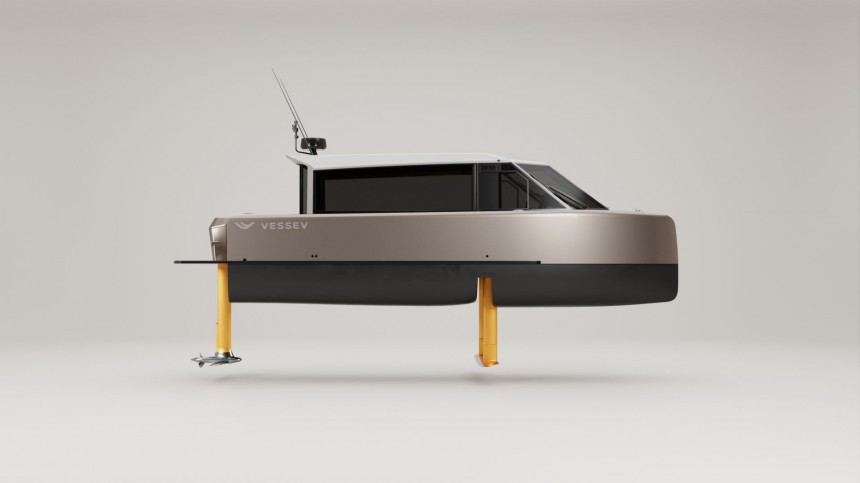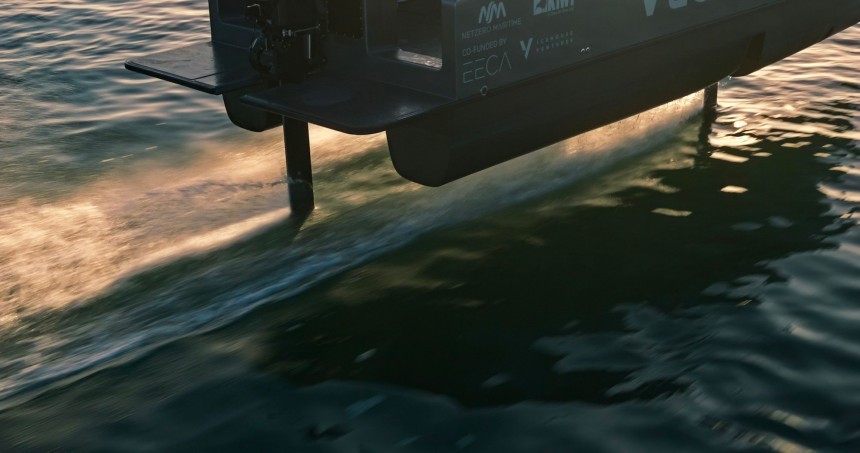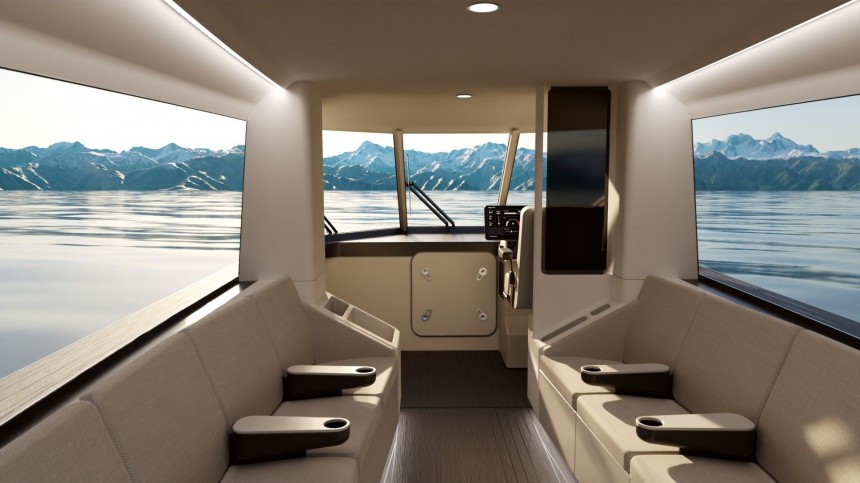As technology advances and human ingenuity mix, we're starting to see all kinds of machines flying around, literally. This is the case with Vessev's VS-9, a hydrofoil, electric passenger ferry that aims to change the face of coastal travel worldwide.
Folks, Vessev is one of those crews that I don't expect you to know about, especially since this team has been working mostly under the radar, developing the future of commercial boating. Well, they've started to unveil the fruits of their labor, and by god, it's friggin amazing!
The vessel is called the VS-9, and it's meant to be the cleanest, quietest, commercial-use boat to be seen flying—not floating—around from port to port. Why would I use the word 'flying' to describe the VS-9? Simply because that's what it does.
I'm talking about this vessel's hydrofoiling abilities. If you've had a chance to view the image gallery or video below, you understand what I'm talking about. Oh, and if you've ever ridden a hydrofoil, then you really know what's in store and why this machine appeals to my mental tastebuds so much.
One of the, as I like to call it, magical aspects of a hydrofoil is its ability to offer a very smooth ride. How smooth? Well, I can compare it to having your very own flying carpet. This feeling is ignited because a hydrofoil will lift the main body or vehicle off the surface of the water, moving it away from any turbulence typically caused by waves.
Part two of the magic is the hydrofoil itself, or that massive main wing sitting underneath the VS-9. Sure, the rear wing has its uses, too, but let's focus on just one of these components so that you can get an idea of what's going on.
Now, as simple as I can put it, the idea behind a hydrofoil is similar, if not exactly the same, as the principle of an airplane wing, with its shape causing lift under a particular speed. As a result, once the main body is lifted off the water's surface, the VS-9 basically flies; water and air behave the same way, only their densities differ.
Well, that lift generated by this boat's wing is so powerful that it can lift entire construction off the water while under a full load. Oh, and rudders built into the wings also help stabilize the VS-9 in case any turbulence is encountered, and all, fly-by-wire.
While I could sit here and talk about the VS-9's flying abilities until the cows come home, another side of things has to do with how the rest of the boat is built and what it can achieve. After all, Vessev is the sort of crew that designs and manufactures every single component found aboard this puppy. From the motor, hull, rudders, and the entire electrical system, it's all in-house magic.
For starters, allow me to ask you what sort of material you think that hull is built out of. Nothing but good old carbon fiber is used to craft the VS-9, and if you know how this material brings things to life, you're aware of the hours of handcrafting needed to breathe life into something like this. I'll give you a hint: A bicycle can take up to 1,000 or more hours to complete. Think about how much time and effort went into the VS-9.
With this material, Vessev gave life to a catamaran hull design that can accommodate up to ten passengers and one captain. But the real hot ticket here is the fact that the commercial cabin version VS-9 weighs no more than 3,100 kg (6,834 lbs). It can also hit a top speed of 30 knots (35 mph), travel up to 50 nautical miles (58 miles), and tackle waves of up to 0.8 m tall (2.6 ft). All thanks to Vessev R&D.
Since the manufacturer is aiming to really shift the way the industry approaches passenger boats, they've come up with something very special. I'm talking about the electrical system behind all the flying fun. According to Vessev, the VS-9 is endowed with a proprietary setup that can achieve the following projections.
Let's say the VS-9 is currently engaged in a "dock-to-dock" service of 10 nautical miles and cruises at a speed of 25 knots (29 mph). This trip is going to take just 27 minutes to complete and will cost only $2.4 in electricity. Now, all that sounds amazing already, especially for ferry operators, but the amazing aspect of all this is a recharge time of just 16 minutes under the above-mentioned conditions. I'm literally out of words right now. Oh, let's not forget about the manufacturer's statement about how the VS-9's propulsion system "reduces energy consumption by up to 95%."
The question is, just how much can operators expect to spend on one of these babies? Well, it's all clearly going to depend on any extra features you may need, but sources state that these babies are already selling starting at $620,000, so quite a bit. It's not clear, however, if that price is in New Zealand Dollars, the country where this crew is headquartered. But with the 20-year warranty this manufacturer offers on the VS-9, if you do the math and everything flows smoothly during operations, you're set for profit in no time.
Since Vessev is now officially on the market and looking to expand, give them a call and see if you can become a partner in changing the way we do port-to-port and coastal travel. Heck, some tourism crews are already exploiting all the VS-9 can do, and maybe your business is the next brand on the list to get on board.
The vessel is called the VS-9, and it's meant to be the cleanest, quietest, commercial-use boat to be seen flying—not floating—around from port to port. Why would I use the word 'flying' to describe the VS-9? Simply because that's what it does.
I'm talking about this vessel's hydrofoiling abilities. If you've had a chance to view the image gallery or video below, you understand what I'm talking about. Oh, and if you've ever ridden a hydrofoil, then you really know what's in store and why this machine appeals to my mental tastebuds so much.
One of the, as I like to call it, magical aspects of a hydrofoil is its ability to offer a very smooth ride. How smooth? Well, I can compare it to having your very own flying carpet. This feeling is ignited because a hydrofoil will lift the main body or vehicle off the surface of the water, moving it away from any turbulence typically caused by waves.
Now, as simple as I can put it, the idea behind a hydrofoil is similar, if not exactly the same, as the principle of an airplane wing, with its shape causing lift under a particular speed. As a result, once the main body is lifted off the water's surface, the VS-9 basically flies; water and air behave the same way, only their densities differ.
Well, that lift generated by this boat's wing is so powerful that it can lift entire construction off the water while under a full load. Oh, and rudders built into the wings also help stabilize the VS-9 in case any turbulence is encountered, and all, fly-by-wire.
While I could sit here and talk about the VS-9's flying abilities until the cows come home, another side of things has to do with how the rest of the boat is built and what it can achieve. After all, Vessev is the sort of crew that designs and manufactures every single component found aboard this puppy. From the motor, hull, rudders, and the entire electrical system, it's all in-house magic.
With this material, Vessev gave life to a catamaran hull design that can accommodate up to ten passengers and one captain. But the real hot ticket here is the fact that the commercial cabin version VS-9 weighs no more than 3,100 kg (6,834 lbs). It can also hit a top speed of 30 knots (35 mph), travel up to 50 nautical miles (58 miles), and tackle waves of up to 0.8 m tall (2.6 ft). All thanks to Vessev R&D.
Since the manufacturer is aiming to really shift the way the industry approaches passenger boats, they've come up with something very special. I'm talking about the electrical system behind all the flying fun. According to Vessev, the VS-9 is endowed with a proprietary setup that can achieve the following projections.
The question is, just how much can operators expect to spend on one of these babies? Well, it's all clearly going to depend on any extra features you may need, but sources state that these babies are already selling starting at $620,000, so quite a bit. It's not clear, however, if that price is in New Zealand Dollars, the country where this crew is headquartered. But with the 20-year warranty this manufacturer offers on the VS-9, if you do the math and everything flows smoothly during operations, you're set for profit in no time.
Since Vessev is now officially on the market and looking to expand, give them a call and see if you can become a partner in changing the way we do port-to-port and coastal travel. Heck, some tourism crews are already exploiting all the VS-9 can do, and maybe your business is the next brand on the list to get on board.



















